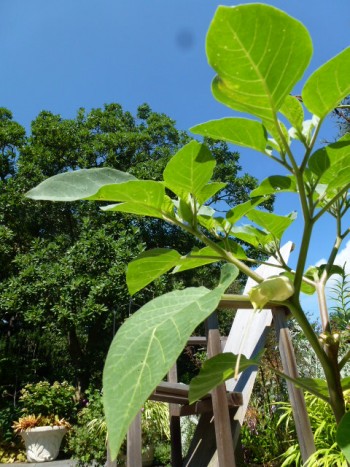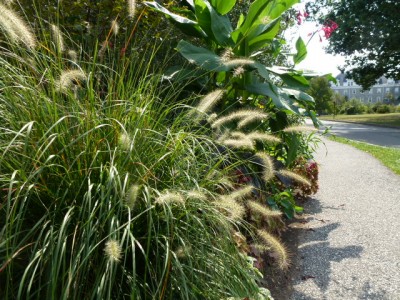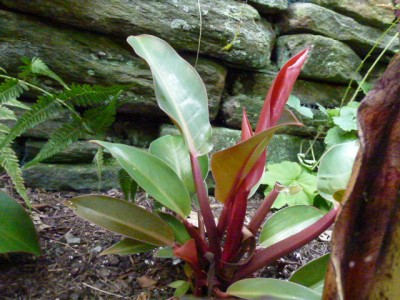Plants of the Week: September 12
I first heard of Datura through a role-playing game I played in college with my friends; an enemy sorceress used powdered Datura as a component for casting spells. As game-lore tries to base itself on real-life examples, Datura is actually used in Navajo, Hindu, Havasupai, and Voodoo rituals.
As far as Datura metel ‘Belle Blanch’ is concerned, it is an annual, herbaceous shrub that tends to grow no higher than 3 feet tall. It prefers sunny, warm, dry places and doesn’t like to be over-watered or fertilized. The plant has dark green foliage and the flowers take the form of beautiful, yellow-white trumpets.
Because Datura metel ‘Belle Blanch’ is pollinated by moths, the flowers emit an especially pleasant fragrance at night, though they can self-fertilize, producing spiky, green seed pods. To avoid over-seeding into the next growing season, remove the pods before the end of September and store for later. Come see (and smell) our Datura metel ‘Belle Blanch’ in the Scott Entrance Garden. Photo credit: D. Alvarez
Pennisetum alopecuroides ‘Hameln’
Also located in the Scott Entrance Garden on the College Avenue side is an attractive and fun grass known as: Pennisetum alopecuroides ‘Hameln’. It is a shrub-like clump grass that grows up to 2.5-feet tall and with a 2.5-feet spread.
Pennisetum alopecuroides ‘Hameln’ prefers full sun, but wet soil. Its most noticeable feature are the soft, wheat-colored, feather brush-like blooms it produces from August to October, hence the common name: fountain grass.
Whenever I pass by them, I can’t help but to reach out and brush my fingers against the alluring, fuzzy flowers. In the fall, the grass blades turn a lovely golden color, but should be cut down in the winter to make way for new growth in the spring. Though it can reproduce by seed, diving the culm is the best way to propagate Pennisetum alopecuroides ‘Hameln’.
If you would like a companion plant to Taxodium ascendens mentioned in my previous article, or would are otherwise interested in starting an everglade or texture garden, Pennisetum alopecuroides ‘Hameln’ is a good choice. Photo credit: D. Alvarez
Philodendron ‘Autumn’
A tropical, shrub-like, evergreen perennial Philodendron ‘Autumn’ makes a striking splash of color to any container or plant border. They prefer partial to full shade, moist, yet well-drained, fertile soil. Philodendron ‘Autumn’ grows up to 2-feet tall and out to 3-feet wide, but unlike other Philodendrons, ‘Autumn’ self-heads. So you don’t have to worry about it trying to climb over your other plants. It requires water only twice a week and can be propagated by stem cuttings as long they have two joints.
New leaves Philodendron ‘Autumn’ seem to undergo reverse senescence; they start out the vibrant, orange-red hues of fall, but end up a spring shade of green. Take a look in the Annual Border in the Terry Shane Teaching Garden.
Photo credit: D. Alvarez








No Comments